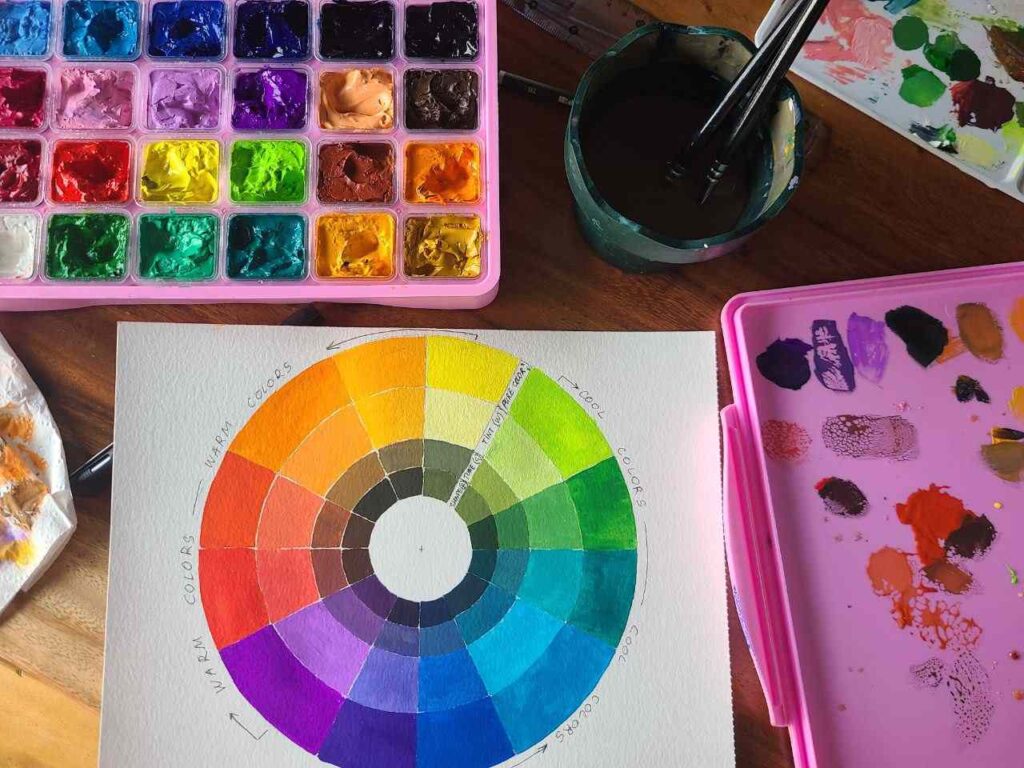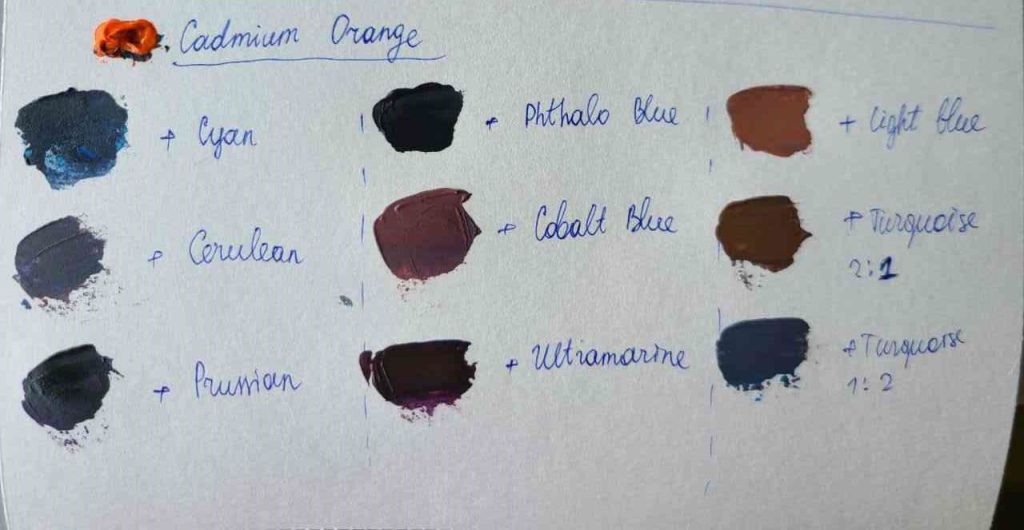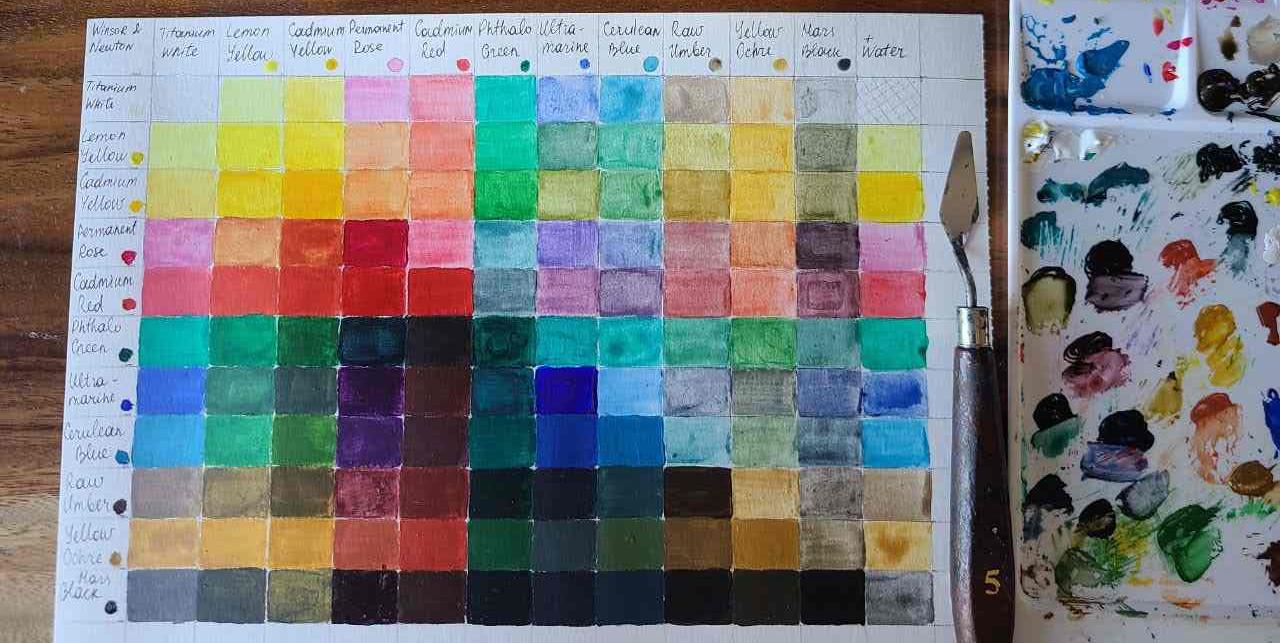Last Updated on March 21, 2024 by Masha Eretnova
When you see orange colors, you might think of a sunrise meeting the blue color of the skies. Imagining it will give you a nostalgic atmosphere. How exciting it would be to discover what color does orange and blue make when mixed.
Orange and blue make brown, or purple or black. There are tons of shades of brown depending on the amount of paint you’ll use. These different shades can be used not only for your paintings but also for your unique interior designs.
So, there’s no need to hold back and pick up those paintbrushes exploring the different shades of brown you can get by mixing blue and orange colors.
Here are some essential keys that you might need to know for mixing blue and orange colors.
Table of Contents
This article contains affiliate links. It means no extra cost for you but a little commission (2-3%) for me to support my hobby and blog. Thank you!
Primary and secondary colors explained on color wheel

Blue is one of the primary colors, together with red and yellow. These three primary colors are part of the RYB color wheel. Mixing these primary colors will give us secondary colors.
Secondary colors are where the shade of orange came from. If you mix red and yellow primary colors like the shade of alizarin crimson red and cadmium yellow you can get an orange color. These are the secondary colors that you’ll get in mixing primary colors such as the following:
- Alizarin crimson + ultramarine blue = purple shade
- Cadmium yellow + ultramarine blue = green shade
Now, mixing these secondary colors will give us tertiary colors. Depending on the shades you use, these are the following tertiary colors that you can get from mixing secondary colors:
- Cadmium yellow + cadmium orange = amber
- Cadmium orange + alizarin crimson red = vermillion/ red orange
- Alizarin crimson red + purple = magenta
- Ultramarine blue + purple = violet
- Ultramarine blue + bright green = teal
- Bright green + cadmium yellow = chartreuse/ yellow-green
Orange and blue are placed in opposite positions in the color wheel chart. These opposite colors are called complementary colors. Mixing a shade of orange and blue will give you brown shades.
However, brown, a neutral color, doesn’t exist in the RYB color wheel chart. You can get brown color by mixing the three primary colors.
To upskill, learn color theory basics with this comprehensive guide: How To Mix Acrylic Paint? – Your Complete Color Mixing Guide
What Color does orange and blue make?

If we mix blue and orange shades, we will get a brown color, purple or grey color. Orange and blue colors are complementary colors. Any complementary colors can also give you brown shades.
- Cadmium orange mixed with Cyan make dark blue
- Cadmium orange mixed with Cerulean Blue make grey
- Cadmium orange mixed with Prussian Blue make black
- Cadmium orange mixed with Phthalo blue make black
- Cadmium orange mixed with Cobalt Blue make dark violet
- Cadmium orange mixed with Ultramarine make deep violet
- Cadmium orange mixed with light blue make light brown (close to burnt sienna)
- Cadmium orange mixed with Turquoise make brown
If you mix red and green, blue and orange, and purple and yellow, you’ll get brown shades. Aside from this, you can get a brown shade by mixing all the primary colors.
Orange comes from a mixture of two primary colors, red and yellow. Mixing orange and blue gives you a brown shade, which is the same if you mix all the primary colors (red, yellow, and blue).
What color do light blue and orange mixed?
If the amount of light blue is greater than cadmium orange, then mixing light blue and orange can give you a shade close to a slate green color or muted blue color.
However, if you add more cadmium orange then it’ll be like a shade of dark caramel color similar to a coffee latte.
What color does baby blue and orange make?
Since orange has more strong pigment than baby blue, mixing orange and baby blue make a shade of brown color.
Though, you can get lighter brown if you use lighter shades of orange.
What color does sky blue and orange make?
Sky blue and orange make a shade similar to the shade you can get in mixing light blue and orange.
You can get either a muted blue color or a warmer shade of brown (if you add more orange to the mixture).
Related: What do Blue and Brown make? Testing 8 Shades of Blue & 6 Brown
How to Mix shades and tints of brown with blue and orange
If you want a lighter version or tint of brown you can start by mixing brown with a little ratio of white paint. Using white paint is a common method to lighten a color.
The more white paint you add, the more you’ll get a lighter brown shade.
On the other hand, you can mix a touch of black with brown color if you want a strong shade or a darker version of the color brown.
However, be careful in adding black paint for it can overwhelm the color brown and turn your mixture into black shade.
If you mixed an equal amount of cadmium orange mixed with ultramarine blue, you can get a nice brown shade.
However, if you want to make warmer shades of brown, you can add a little amount of red paint like alizarin crimson or red-orange color.
Adding more orange
If you add more orange shade than blue, then the result will give you a warmer brown shade.
Adding more orange is one of the ways if you want to have darker brown shades.
These warm brown shades you can get are the following:
- nutmeg brown
- dark chocolate
- mahogany colors
Adding more blue
Depending on the blue shade you use, adding more blue can give you a cooler shade of brown like chestnut brown since blue is considered to be a cool color.
Most popular brown hues
Brown hue is popular to use either for a neutral or natural look. With that, here are some known colors of brown that you can use:
- beige
- tan
- espresso
- dark chocolate brown
The most popular brown hue used in painting is burnt umber because of its rich and dark red tones that are very useful in color mixing.
How to use brown in painting and drawing?
In painting, different brown tint or shade is used to give highlights to people’s portraits. These different shades serve as neutralizers to give tints, shades, and tones of other colors.
Cooler brown shades are best to use in painting dark furs, wintry trees, and wood tones, while warmer brown shades are commonly used for painting realistic hair, giving highlights to people’s portraits, and natural landscapes.
Uses of the color brown in painting and drawing provide a vast range of techniques in different mediums such as the following:
- acrylic
- gouache
- oil paint
- watercolor
- colored pencils
As such, here are different mediums you can use in painting:
| Acrylic paints | In using acrylic as your medium, we recommend to mix blue and orange paint first in a palette and then add the acrylic gel or known as retarders. It slow the drying effect of your painting. Using brown paint will give rich and darker shades to your painting. |
| Oil paints | In using oil paint, you can have more control over the shade you will get because oil paints tend to dry more slowly than acrylic paint. If you get a darker shade of brown, it’s best to pair it with other darker and warmer colors. However, be mindful of using oil paint because it’s not completely beginner friendly. Brown shades are often use for underpainting with oil paint. |
| Watercolor | Using watercolor will give you a softer or pastel shade of brown. However, it can be difficult especially if you’re a beginner because the strokes might leave visible patches and lines. To avoid this, blend or mix two colors while it’s still wet to avoid lines and patches. |
| Gouache | If you prefer gouache, you can apply this with the same technique as applying watercolor. However, for better results, applying brown paint while it’s still wet is the key to have better control when you create brown color. Gouache is also more beginner-friendly and popular with children than acrylic paint since it creates soft edges and can be repainted just by adding a little water. |
In terms of drawing, dark brown is good to use for nature themes, especially in creating shadows. Brown colored pencils are also popular to use for natural brown hair and other hues of brown.
How to use brown in design?
The brown color pattern is best to use for room walls and floors since it gives minimal, modern but simple room themes. For wood flooring, light walnut is popular to use for it gives a cleaner look to the room. Brown is also best to use with other neutral colors to add depth and avoid an intense atmosphere.
Brown is also popular to use in kitchen cabinets and in kitchen walls. It’s also best to use as balance in a room. For example, a beige sofa paired with a dark color table balanced each other.
There are other colors that go well with brown, which are the following:
- Serenity blue
- Red
- Navy blue
- Orange
- Pink
Brown color can be seen as well in stone and wood textures because it brings comfort and wholesomeness to a room. It can also be used for furniture and home decor because brown gives a vintage atmosphere and brings elegance so you can also see this color being used in exquisite buildings.
Aside from interior designs, brown is also used by other creators of logos and advertisements to give highlights. Usually, dark brown or warmer brown shades are used to capture the attention of the audience.
Blue and orange mixed with other colors
Even though blue is one of the primary colors, there are different shades of blue as well as orange. Mixing the different shades of blue and orange with other colors will give us various shades.
For example, if you use ultramarine blue and mix it with cadmium orange and alizarin crimson, you can get a warmer shade of brown like burnt umber and burnt sienna.
If you have a basic brown shade and you add a touch of black paint, you can get a chocolate brown shade.
Adding a hint of black to cadmium orange can give you a similar shade of yellow ochre or yellow oxide. Mixing this shade with blue can also give you a warmer shade of brown.
What color does blue, green and orange make?
If you mix blue, green and orange, you can get a shade close to bluish-green since blue and orange are both complementary colors, they will clash with each other, leaving the hue of green. Though the shades of orange and blue will also reflect the resulting shade you’ll reach.
What color does blue orange and yellow make?
Mixing blue and orange makes brown. Adding it with yellow will give you a lighter hue of brown color, the more yellow you add the more lighter you’ll get. Yellowish brown shades that you can get are the following:
- khaki
- tan
- buff colors
What color does blue orange and purple make?
Adding purple or other shades of it like magenta and mixing it with blue and orange will make brown darker, the more purple you add, the darker the brown shade you will get like plum shade.
What color does pink, orange and blue make?
If pink is created from the mixture of cadmium red and white, adding it to orange and blue will give you a light brown shade. Though it still depends on the amount of white and red you mix with orange and blue until you get your desired brown shade.
How to combine blue and orange in design?
An orange-blue color pattern is best for kids’ playrooms and bedrooms since its lively color give brightness to the room. If you use orange as wall paint, you can use its complementary color, blue, in sofas and tables to give balance and calm the bright color of orange.
Orange is a warm color while blue is a cool one. As primary and secondary colors, orange and blue can contrast and complement each other.
For example, you can pair an orange peel sofa with a pastel serenity blue wall and vice versa. The key is to use a dark and light shade between orange and blue to balance their colors.
There are other colors that go well with orange and blue, such as:
- Pink (bold combination)
- White
- Beige (beige will tone it done a bit)
- Gold
- Yellow
- Brown
- Grey
Aside from interior designs, the color combinations of orange and blue are good to use in highlighting words in logos and advertisements.
With the right use of their different shades, the orange-blue color pattern is best for different fields of design.
FAQs
Does blue and orange make green?
No, mixing blue and orange will give you a brown hue. If you want to get a green color, mix any shade of yellow and blue like cadmium yellow and ultramarine blue then you can get a shade of green.
Are blue and orange complementary colors?
Yes, in the color wheel blue and orange are two opposite colors that can complement and contrast with each other. Blue is a primary color while orange is a secondary color.
Does orange cancel out blue?
Yes, since orange and blue are both complementary colors, adding orange to the other will make the blue color disappear or can contrast with each other. However, it still depends on how light and dark the color you’ll use.
Wrap Up
The orange-blue color combinations will definitely give you a brown shade. Depending on how light and dark the shades you’ll use, you can get warmer and cooler shades of brown. These are best for your nature-theme paintings.
So what are you waiting for? Grab that paintbrush and let’s dive into this exciting discovery of colors! Have a good day everyone!

Masha Eretnova, born in 1991, is a Buenos Aires-based certified teacher, artist, and member of the Professional Artist Association with 20+ years of personal painting journey.
She started painting and drawing very early and is now an international abstract artist and educator passionate about acrylic painting, gouache, and crafts.
Her works are part of international exhibitions and contests, including ArtlyMix (Brazil), Al-Tiba 9 (Spain), Exhibizone (Canada), Italy, and many more.
Besides her artistic pursuits, Masha holds a post-grad diploma in Teaching Film Photography and 2 music school diplomas: piano and opera singing.
